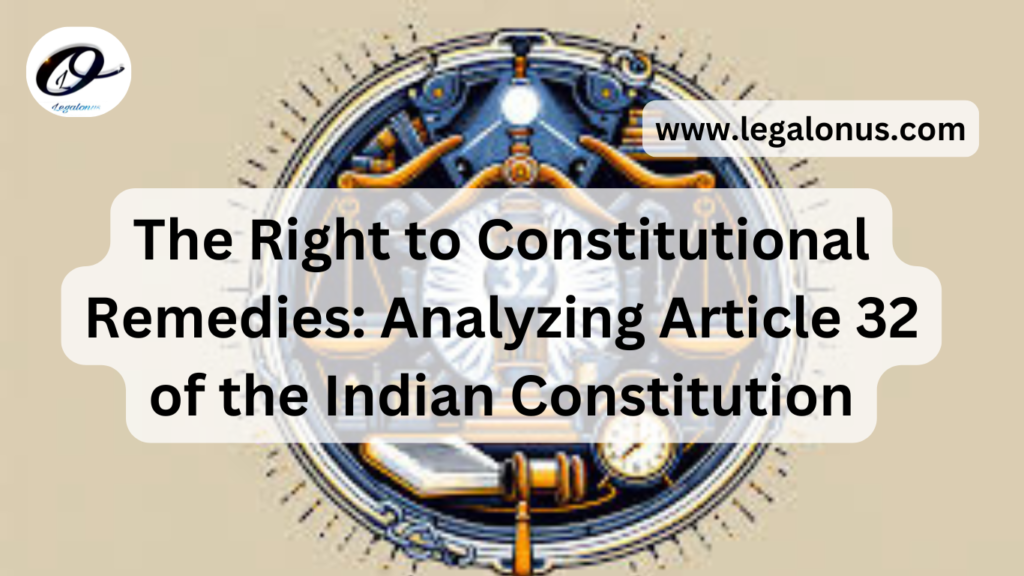
Abstract-
Any Constitution would be deemed incomplete without including the Fundamental Rights. Enforcing them equally without any prejudice is the duty of the state. These rights would be rendered ineffective if there is no supervisory or control to oversee them. Article 32 is one such means through which fundamental rights are secured. Article 32 comes under ‘Part III of the Constitution’ dealing with fundamental rights. Through this, people have legal recourse to enforce their basic rights if a state fails to provide them. Here, the Supreme Court plays a significant role in assessing the situation and granting the necessary order. Not all countries have similar articles like 32 in their respective constitution. Without this article, it would have created a big loophole in the judicial system and resulted in serious repercussions.
Key Words- Article 32, Constitutional Remedies, Fundamental Right, Writs
Introduction
The Constitution is said to be the supreme law of the land. All the rights, powers, and duties are derived from the Constitution. Fundamental Rights are the most crucial set of rights given to an individual. The state must ensure that such rights are equally provided to all without discrimination. But what happens when such rights are not given to a person or his rights are infringed? What remedy does a person have to enforce the right that should be legally given to him? To overcome this challenge, our constitutional makers carefully crafted a provision that would empower individuals to seek remedy. “This provision is Article 32 of the Indian Constitution, called the Right to Constitutional Remedies. This article is important because it allows people to directly approach the Supreme Court, whenever their fundamental right is infringed”[1]. Dr. BR Ambedkar often hailed as the chief architect of the Indian Constitution, said Article 32 is the “heart and soul of the Indian constitution”. Article 32 is not just any other provision under the Constitution. It is a fundamental tool for safeguarding core principles like justice, liberty, and equality. This Article focuses on understanding the meaning and scope of Article 32, its significance with the help of landmark cases, the latest developments, and a comparison of the right to constitutional remedies with other countries.
The Meaning and Scope of Article 32-
Text of Article- The Article says-
- “The people can approach the Supreme Court through appropriate legal measures for enforcing rights mentioned under Part III of the Constitution.
- The Supreme Court will have the power to issue directions or orders including writs whichever may be appropriate for enforcing rights under this provision”[2].
- The parliament shall have the authority to enforce the same rights as any other court the same powers conferred upon Supreme Court.
- In no circumstances, this right shall be revoked unless provided by any other provision under the Constitution.
Understanding Article 32- The Heart and Soul of the Constitution-
- Fundamental Nature-
Article 32 is a fundamental right. It acts as a “guarantor for all other fundamental rights” mentioned in the Constitution. This provision ensures that no individual is arbitrarily deprived of basic human rights.
- Writ Jurisdiction-
The prerogative writs have been common throughout the history of Independent India. 5 different writs can used before the court to enforce fundamental rights. These writs are as follows-
- Habeas Corpus-
Whenever police misuse their power and keep a person under unlawful detention without any lawful justification, that person has the right to use the writ of Habeas Corpus. “The literal meaning of this writ is to produce a person wrongfully detained before the court and the court is satisfied then that person can be set free”[3].
- Mandamus-
“This writ compels the public official or authority to perform the duty they are bound to perform”[4].
- Prohibition
“It prevents the lower court or tribunal from exceeding its jurisdiction and staying within the court’s jurisdiction”[5].
- Certiorari
This writ is used to “quash the order of the lower court or tribunal” over the jurisdiction issue.
- Quo- Warranto
This writ verifies and ascertains the legality of a person’s claim to a public office.
These writs act as “judicial remedies ensuring the fundamental rights enriched under part III of the constitution are protected”[6].
Judicial Interpretation of Article 32 with the help of Landmark Cases-
Romesh Thappar vs State of Madras,1950
“It was one of the earliest cases where the Supreme Court invoked Article 32. The case primarily deals with Article 19(1)(a) which provides freedom of speech and expression”[7]. The court struck down the controversial state law that impose restrictions on the circulation of a journal, asserting that freedom of expression cannot be curtailed unless explicitly permitted by the Constitution.
Kesavananda Bharati vs State of Kerala, 1973
In this landmark case, the Supreme Court held that the basic structure of the Constitution cannot be amended[8]. This further cemented the role of Article 32 as a means to protect fundamental rights and basic structure”. This judgment highlighted the inviolability of constitutional remedy in safeguarding democracy.
Maneka Gandhi vs Union of India, 1978
This case further increased the scope of Article 21 (right to life and personal liberty) and emphasized the golden triangle- Articles 14, 19, and 21. Invoking Article 32, the court ruled that the procedure established by law must be fair, reasonable, and just”[9].
Bandhua Mukti Morcha vs Union of India- 1984
This case emphasized the use of the Public Interest Litigation mechanism. “The court recognized the bonded labor’s right to live with dignity under Article 21. The court reiterated that Article 32 could be used as a tool for social justice making it more accessible for all”[10].
DK Basu vs State of West Bengal 1997
This case proved to be pathbreaking for protecting the rights of individuals from custodial violence. “The Supreme Court held that any form of custodial torture infringes upon individual right to life and personal liberty under Article 21. The court by invoking Article 32 ensured that fundamental rights are not violated while in police custody”[11].
Limitations to Article 32-
While the article serves as a protector of fundamental rights, it does have certain limitations.
No enforcement at the time of emergency-
Article 32 can be suspended during times of emergency. “Article 359 of the Constitution says the right to constitutional remedies is rendered useless during emergencies; thus, it is futile during a crisis. This happened during the infamous emergency imposed by the Indira Gandhi government in 1975”[12].
No Independent Judicial Discretion-
The writs issued under Article 32 are discretionary. This means that the Supreme Court is not made compulsory to issue writs. If the court is satisfied then only it will issue writ. Therefore, the court can choose not to entertain the petition. This discretion can be backfired in sensitive cases.
Heavy Burden on Supreme Court-
Already there are thousands of cases pending before the apex court. Article 32 allows a person to approach the court directly, increasing the burden. This has led to delays in justice, raising concerns about timely justice.
Exclusivity-
Article 32 applies to the violation of only Fundamental rights. Legal or other constitutional rights are excluded, restricting the scope and ambit.
Latest Development
Recently there are some notable examples where Article 32 has been used to enforce fundamental rights.
Navtej Singh Johar vs Union of India-
In this historic ruling, Article 32 was invoked to decide the “constitutionality of Section 377 of the erstwhile Indian Penal Code. Section 377 criminalized consensual homosexual activities, which violated the rights of persons[13]. The Supreme Court taking cognizance, decriminalized homosexuality and held Article 14 (right to equality) and Article 21 (Right to life, liberty, and privacy) were violated by Section 377”.
Shayara Bano vs Union of India, 2017
Under Muslim personal law, there was a practice of giving instant divorce to the wife by the husband. This was called triple talaq or talaq-e-biddat. In the present case, Article 32 was invoked to challenge this practice. “The Supreme Court held this unconstitutional violating the rights of married women and Articles 14 and 21. The judgment highlighted the corrective and protective role of Article 32 in addressing violations of fundamental rights”[14].
Anuradha Bhasin vs Union of India-
After the revocation of Article 370 in Jammu and Kashmir, the government imposed a blanket ban on the internet in the entire region. The ban was prolonged for months, therefore violating people’s rights. Article 32 was invoked to examine the legality of the indefinite shutdown of the internet. “The court held that the right to the Internet is a fundamental right in Article 19, further emphasizing the need for Article 32”[15].
Comparison of Article 32 with Constitutional Provisions across the world-
The Indian Constitution, under Article 32, provides direct and enforceable rights to constitutional remedies, empowering the people to approach the Supreme Court. This provision is fundamental in India’s Constitutional framework. The mechanism of enforcing fundamental rights varies from country to country. Here we shall compare the right to constitutional remedies with India and the USA, UK, Canada, and Australia.
United States- Judicial Review and Writ of Certiorari
In the United States, enforcement of fundamental rights primarily takes place through judicial review and the exercise of writ jurisdiction of the Supreme Court.
Judicial Review-
The precedence of judicial review was established in the case of Marbury vs Madison (1803). “It gave the Supreme Court authority to declare laws or executive actions unconstitutional”[16].
No Direct Right to Constitutional Remedies-
While India has Article 32, no specific provision in the US Constitution guarantees a “direct right to move the Supreme Court for violation of fundamental rights”. People refer to lower courts before approaching the Supreme Court.
Writ of Certiorari-
“Individuals file a writ of Certiorari before the Apex Court, asking to review a lower court decision”[17]. The court has the discretion whether to entertain the petition and grant it only in certain cases.
“Bill of Rights-
The Bill of Rights is a cornerstone of the American Constitution, it guarantees fundamental rights like freedom of speech, fair trial, and protection from unlawful search and seizure”[18]. Remedies for violation of these rights are sought through judicial review.
Comparison with India-
In India, there is an imposition on the Supreme Court to hear cases involving breach of fundamental rights under Article 32, In the USA the SC has the discretion to accept the case. Furthermore, the remedies are pursued through multi-tiered judicial review rather than directly before the highest court.
United Kingdom- Common Law and the Human Rights Act 1998
In the UK, there is no written constitution. It operates under the system of common law and parliamentary sovereignty. “An individual’s constitutional rights are protected through the Human Rights Act 1998. It incorporates the European Convention on Human Rights (ECHR) into domestic law”[19].
The Human Rights Act-
“It allows a person to enforce their rights under ECHR in domestic courts. If the court believes the law infringes human rights, it issues a declaration of incompatibility encouraging parliament to amend the law”[20]. In India, courts don’t have this right.
Judicial Review-
Individuals can challenge the public authorities if their fundamental right is violated. Judicial review plays an important role in protecting rights. However, this right is limited to declarations rather than acts or laws.
Comparison with India-
In India, the Supreme Court can nullify the laws that violate fundamental rights. In the UK the courts are limited to nullifying only certain declarations under Human Rights Act. Further, the UK does not have a direct, constitutional provision like Article 32 to preserve constitutional remedy.
Canada- Charter of Rights and Freedom-
“The Canadian Charter of Rights and Freedoms 1982, provides constitutional protection for individual rights and freedom. Section 24 of the charter deals with the enforcement of these rights”[21].
Section 24-
It gives individuals the right to seek remedies in a competent court if the rights under the charter are infringed. The Supreme Court of Canada can grant remedies like damages, invalidating acts, or giving injunctions.
Section 52-
If a law or act violates the Charter right, then the Constitution Act, courts can declare the law null and void.
Judicial Review-
Like the USA and India, Canada also has similar enforcement of Judicial Review to strike down laws that violate the charter. Individuals can approach the lower court first and then move to the Apex Court.
Australia-
In Australia, constitutional rights are protected through judicial review and there is no direct equivalent to Article 32.
Implied Rights and Limited Explicit Rights-
Australian Constitution contains limited explicit rights, unlike India. The majority of constitutional rights are either implied or found in statutes.
Judicial Review-
Like other countries, the High Court of Australia is empowered with a judicial review mechanism. Individuals can challenge laws or actions that violate their rights.
Writs-
“Section 75 provides the original jurisdiction of the High Court of Australia to issue writs like mandamus, prohibition, and injunction”[22]. These writs however do not have the broad remedial purpose that Article 32 provides in India.
Comparison with India-
Australia lacks a formal Bill of Rights, limiting the extent to which citizens can claim explicit constitutional protection compared to India. The High Court of Australia has a narrower remedial scope than Article 32.
Consequences of Lack of Article 32
Had Article 32 which gives the Right to Constitutional Remedy not included in the Constitution, it would have serious implications. In the Absence of Article 32, the judiciary’s ability to safeguard individual rights would have been severely limited and citizen recourse to justice for violation would be fruitless.
Here are some of the probable impacts and how to overcome them-
- Weak enforcement of Fundamental Rights-
“Without Article 32, an individual’s right to approach the Supreme Court would be curtailed enforcement of their fundamental right”[23].
Limited Accessibility: Without the Supreme Court, people would have to approach lower courts for relief. However, the lower court may lack the means to tackle the issue. This would delay the justice process as people would have to file further petitions in higher courts.
Increasing vulnerabilities- the “Golden Triangle of Articles 14, 19, and 21” is of paramount importance. These rights if infringed would mean people won’t have robust, immediate mechanisms for relief.
- Erosion of Judicial Supremacy and State Accountability-
Through Article 32, “the Supreme Court acts as the guardian of the Constitution and protector of fundamental rights”. If Article 32 is removed the court’s ability to hold executive and legislature accountable for any unconstitutional law would be reduced.
The checks and balances on the branches of government would not be effectively possible. Further judicial review would be rendered as a less powerful tool.
- Impact on Social Justice and Public Interest Litigation (PIL)
The development of PIL has been made possible through Article 32. It has given access to marginalized and underrepresented groups to approach the Supreme Court. Without Article 32 socially and economically disadvantaged groups would not have avenues to resolve their violation of rights.
PILs like Bandhua Mukti Morcha [relating to bonded labors] and “Olga Tellis [Right to livelihood]”[24] would be hard to achieve. Further, there would be delays in social reforms like decriminalizing Homosexuality [Navtej Singh Johar case] or “the Right to Privacy as a fundamental right”[25] [KS Puttaswamy].
- Overburden of High Courts-
The number of applications under Article 226 would rise exponentially, without Article 32. High Courts would be primarily responsible for enforcing fundamental rights. Thus, the HCs would be overburdened with cases. This would result in a slowdown of the judicial process, resulting in severe backlogs of cases.
Possible Measures-
In a Hypothetical scenario without Article 32, there are still certain measures that could be taken to strengthen the Constitutional mechanism-
Consolidation of Article 226-
Article 226 already has a broader scope than Article 32, covering fundamental and legal rights. High Courts have the power to issue the writs for enforcement of rights. Therefore, increasing the resources of the High Court seems most reasonable, to handle the increased burden. This can be possible by increasing the number of judges, upgrading court infrastructure, and implementing an effective case management system. Furthermore, the scope and power of Article 226 can be expanded to cater to the demands of justice.
Creation of Specialized courts having Constitutional Powers
Establishing such courts across the country exclusively dealing with cases of fundamental rights violation would ease the pressure on the judiciary.
Fundamental Rights Protection Act-
Parliament can introduce the Legislative mechanism through the Fundamental Rights Protection Act. The act will specifically deal with enforcing the fundamental rights of individuals.
Strengthening the powers of the National Human Rights Commission [NHRC]
Currently, NHRC lacks the adequate means to enforce human rights. It has only recommendary powers. NHRC can be strengthened by increasing its scope and giving full autonomy, it can be beneficial in enforcing fundamental rights.
Conclusion-
Article 32 stands out as a critical component of the Constitution. It stands as a robust safeguard for the protection of fundamental rights, giving the judiciary the power to act as a “protector of civil liberties. It has played a transformative role in promoting social justice” through tools like public interest litigation. There are some limitations, but that has not stopped the importance of Article 32. This article stands on the pedestal of securing the rights of citizens and acts as a beacon of hope upholding the rule of law.
[1] Blogspot.com. (2023). Constitutional Law. [online] Available at: https://lmslaw.blogspot.com/2023/02/constitutional-law.html
[2] Constitution of India. (2023). Article 32: Remedies for enforcement of rights conferred by this Part – Constitution of India. [online] Available at: https://www.constitutionofindia.net/articles/article-32-remedies-for-enforcement-of-rights-conferred-by-this-part/
[3] Chakrabarty, B. (2019). India’s Constitutional Identity. Routledge.
[4] Ghorpade, P. (n.d.). Analysis Of Writ Of Mandamus. [online] www.legalservicesindia.com. Available at: https://www.legalservicesindia.com/article/592/Analysis-Of-Writ-Of-Mandamus.html.
[5] Ibid.
[6] Supra note 1
[7] Tandon, U., Parasaran, M. and Luthra, S. (2019). BIODIVERSITY : law, policy and governance. S.L.: Routledge India.
[8] AIR 1973 SUPREME COURT 1461 Kesavananda Bharti vs State of Kerala
[9] 1978 AIR 597 Maneka Gandhi vs Union of India
[10] AIR 1984 SUPREME COURT 802 Bandhua Mukti Morcha vs Union of India
[11] AIR 1997 SUPREME COURT 610 DK Basu vs Union of India
[12] Adv Hemant More (2023). National Emergency (Articles 352-355, 358, 359). [online] The Legal Quotient. Available at: https://thelegalquotient.com/constitutional-law/national-emergency/1661/
[13] AIR 2018 SUPREME COURT 4321 Navtej Singh Johar vs Union of India
[14] AIR 2017 SUPREME COURT 4609 Sharaya Bano vs Union of India
[15] AIR 2020 SUPREME COURT 1308 Anuradha Bhasin vs Union of India
[16] 5 U.S. (1 Cranch) 137 Marbury vs Madison
[17] Singh, N. and School, U. (1973). India and International Law. New Delhi : S. Chand.
[18] Robertson, D. (2004). A Dictionary of Human Rights. Routledge.
[19] Web.app. (2019). Dh human rights act 1998 pdf. [online] Available at: https://dalliaboldser.web.app/1179.html
[20] Equality and Human Rights Commission (2018). The Human Rights Act. [online] www.equalityhumanrights.com. Available at: https://www.equalityhumanrights.com/human-rights/human-rights-act.
[21] Romanow, R.J. (1986). The Canadian Charter of Rights and Freedoms. Canadian Social Work Review / Revue canadienne de service social, [online] 4, pp.9–21. Available at: https://www.jstor.org/stable/41669205.
[22] Section 75 of Australian Constitution 1901
[23] Supra note 17
[24] AIR 1986 SUPREME COURT 180 Olga Tellis vs Bombay Municipal Corporation
[25] AIRONLINE 2018 SC 237 KS Puttaswamy vs Union of India
This article has been written by Nandan Rathi, a 5th year law student at Hidayatullah National Law University.







